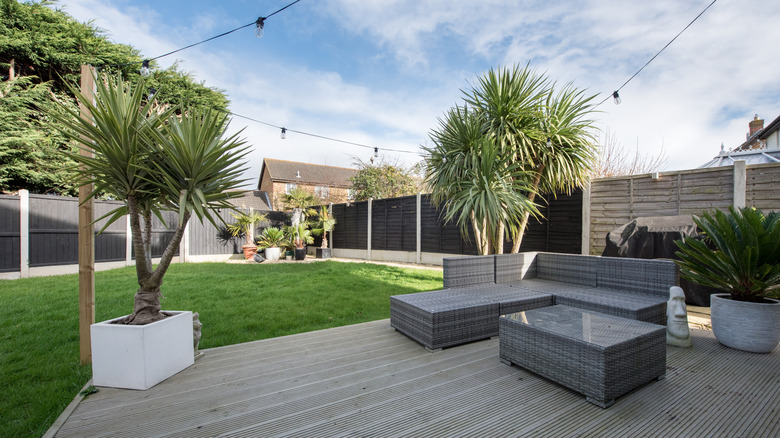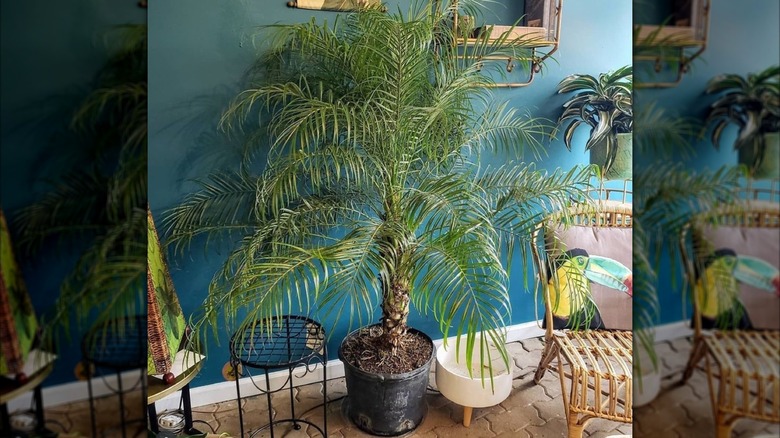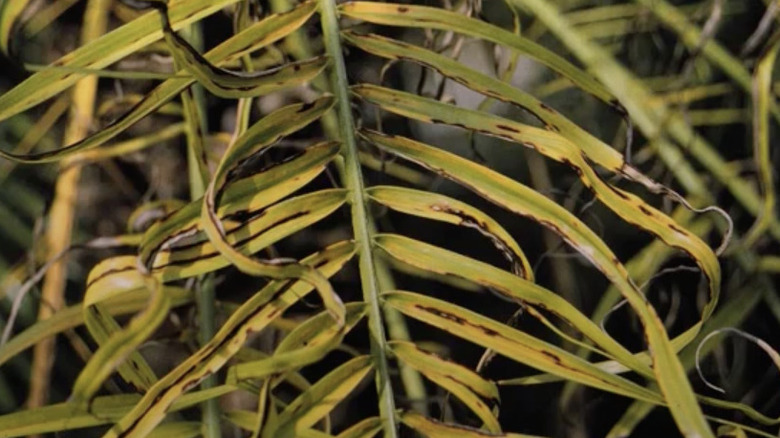The Small Palm Tree That Can Grow In A Container Just As Well As In The Garden
We may receive a commission on purchases made from links.
Palm trees have long been synonymous with tropical beach vacations. We picture them waving in the warm breeze over sparkling blue water — a true paradise. For most of us, however, this setting is far from our everyday reality. But the good news is that, regardless of climate, we can bring a small piece of this exotic getaway into our gardens and homes by growing a pygmy date palm (Phoenix roebelenii) in a container and in the garden.
While palm trees are known for being tall — with some reaching as high as 100 feet — quite a few varieties, including the pygmy date palm, are more compact and work well as a patio container plant or as a houseplant. If you live in USDA Hardiness Zones 10 and 11, you can even grow this compact palm in the ground where it won't outgrow the space. Outdoors, it will stretch to slightly more than 6 feet high and 5 feet wide. Indoors, it will max out around 5 to 6 feet, giving you a taste of the tropics without crowding your living room with fronds. However, its lower leaves are tapered and sharp, so keep the tree out of high-traffic areas. Caring for the pygmy date palm in a container versus in the ground is similar, but some slight differences should be on your radar.
Housing pygmy date palms inside and outside
Whether they're grown indoors or outdoors, palms love humid, warm weather, which is typical care for many indoor foliage plants. Remember that tropical beach? Try to recreate that indoors, minus the sand. Give them humidity with a humidifier or a saucer of gravel, plenty of sunlight (but not hot afternoon sun), and protect them from cold drafts, especially in the winter.
When growing a pygmy date palm in a container, give it moist, well-draining soil, like Miracle-Gro's cactus, palm, and citrus potting mix. You can also mix coarse sand or perlite into standard potting soil to give pygmy date palms the aeration and drainage they need. Once it is potted, you won't need to repot a palm very often since they don't mind being slightly root-bound.Just look out for signs that the palm is outgrowing its current pot, like roots emerging from drainage holes or slower growth than normal, and then repot during the active season.
If your palm is staying outdoors year-round, cover them when temperatures go below freezing to avoid frost burn. You can also move containers near the house or under larger trees for protection from wind and rain. Young palms will be particularly vulnerable to cold temperatures, so provide extra care when they're getting established, and consider moving them indoors if you're expecting a particularly chilly and extended winter. Keep an eye out for frost damage like dark areas near the crown of the tree, sogginess, or brown patches on older leaves.
Feeding and watering tips for a pygmy date palm
Pygmy date palms love moist soil, but be careful not to overwater to the point of causing root rot.Remember that in the fall and winter, the palm needs less water. On particularly hot weeks, water the plant deeply in the morning and around the entire container — not solely around the tree trunk. Palms have an extensive root system, so they can draw water from the surrounding soil, especially when planted in the ground. The deeper you water it, the less frequently you'll need to do it.
If your palm tree's leaves are turning brown or yellow, and you suspect root rot, adjust your watering schedule. Before watering, poke your finger into the soil. Give it a drink only when the top inch or two is dry. If you notice an increase in brown leaf tips, your palm may be telling you that it needs a stronger drink, meaning water deeper. It could also be a sign of being sensitive to chemicals in the water, so try rainwater or distilled water — cocktail umbrella optional.
Palms don't need a lot of fertilizer, but those grown in containers can benefit from fertilization during warmer seasons — once in the spring and once again in the summer. Common nutrient deficiencies include magnesium, potassium, boron, nitrogen, and iron. If your palm is lacking any of these nutrients, you may see symptoms like yellowing crowns and leaves or discoloration on the foliage. Its placement on newer or older leaves also will help determine what deficiency your palm is suffering from. Thankfully, most of these issues are easily addressed with a palm-specific slow-release fertilizer.


